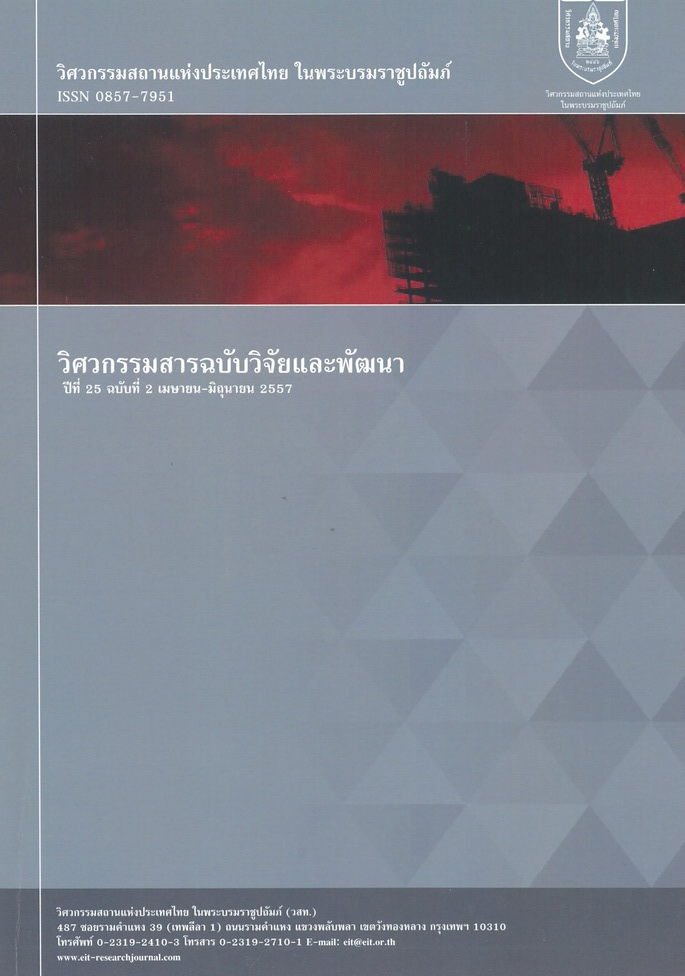INFLUENCE OF SOIL PROPERTIES ON COPPER SORPTION AND DISTRIBUTION FROM SEWAGE SLUDGE LEACHATE IN SOILS
Main Article Content
Abstract
การศึกษานี้มีวัตถุประสงค์เพื่อศึกษาถึงอิทธิพลของคุณสมบัติดินต่อการซับและการกระจายตัวของทองแดงจากน้ำชะละลายสลัดจ์น้ำเสียชุมชนในดินจากพื้นที่กรุงเทพฯและจังหวัดใกล้เคียง ผลการศึกษาพบว่าไอโซเทอร์มของฟรุนดลิชและแลงเมียร์อธิบายกลไกของการซับทองแดงในดินได้ดี โดยมีค่า R2 อยู่ระหว่าง 0.972-0.999 และ 0.916-0.996 ตามลำดับ ค่าสัมประสิทธิ์จากการซับจากไอโซเทอร์มฟรุนดลิชมีค่าในช่วง 24.47-67.97 (มก./กก.)(ล./มก.)1/n และมีความสัมพันธ์อย่างสูงกับปริมาณเหล็กและแมงกานีสออกไซด์ แคลเซียมคาร์บอเนต สารอินทรีย์ ความสามารถในการแลกเปลี่ยนประจุบวก และอนุภาคดินเหนียวในดิน ขณะที่ค่าความสามารถในการซับทองแดงสูงสุดจากไอโซเทอร์มแลงเมียร์มีค่าในช่วง 54.05-217.39 มก./กก. องค์ประกอบรูปแบบทางเคมีของทองแดงในดินหลังจากการซับส่วนใหญ่อยู่ในรูปสารอินทรีย์ และออกไซด์ของเหล็กและแมงกานีส การวิเคราะห์ความสัมพันธ์ระหว่างคุณสมบัติของดินกับสัดส่วนรูปแบบของทองแดงแสดงให้เห็นว่าค่าความสามารถในการแลกเปลี่ยนประจุบวกและปริมาณอนุภาคดินเหนียวถือเป็นคุณสมบัติที่สำคัญที่สุดที่มีผลต่อรูปแบบการกระจายตัวของทองแดงในดิน
The objective of this study was to investigate the influence of soil properties on Cu sorption and distribution from sewage sludge leachate in soils from areas within Bangkok and nearby provinces. The results showed that both the Freundlich and Langmuir isotherm can be well described the sorption phenomena of Cu in all soil types with the R2 of 0.972 to 0.999 and 0.916 to 0.996, respectively. The sorption coefficient from the Freundlich isotherm ranged from 24.47 to 67.97 (mg/kg)(L/mg)1/nand highly correlated with Fe-Mn-oxide, CaCO3, organic matter, CEC and clay content in soils. The maximum Cu sorption capacity from the Langmuir isotherm varied from 54.05 to 217.39 mg/kg. Results from the sequential extraction of the sorbed Cu in soils indicated that the predominance of Cu associated with the organically bound and Fe-Mn oxide bound fractions. Correlation analysis between soil properties and different Cu fractions indicated that cation exchange capacity and clay content were the most important soil properties contributing the relative distribution of Cu to different fractions.
Article Details
The published articles are copyright of the Engineering Journal of Research and Development, The Engineering Institute of Thailand Under H.M. The King's Patronage (EIT).


